一、代码示例
下面是简单的Netty代码示例代码示例,核心模块在其中均有体现,后续的模块组件都以该代码作为示例。
1、Server
public class NettyServer { public static void main(String[] args) { //创建BossGroup 和 WorkerGroup //说明 //1. 创建两个线程组 bossGroup 和 workerGroup //2. bossGroup 只是处理连接请求 , 真正的和客户端业务处理,会交给 workerGroup完成 //3. 两个都是无限循环 //4. bossGroup 和 workerGroup 含有的子线程(NioEventLoop)的个数 // 默认实际 cpu核数 * 2 EventLoopGroup bossGroup = new NioEventLoopGroup(1); EventLoopGroup workerGroup = new NioEventLoopGroup(); //8 try { //创建服务器端的启动对象,配置参数 ServerBootstrap bootstrap = new ServerBootstrap(); //使用链式编程来进行设置 bootstrap.group(bossGroup, workerGroup) //设置两个线程组 .channel(NioServerSocketChannel.class) //使用NioSocketChannel 作为服务器的通道实现 .option(ChannelOption.SO_BACKLOG, 128) // 设置线程队列得到连接个数 .childOption(ChannelOption.SO_KEEPALIVE, true) //设置保持活动连接状态 // .handler(null) // 该 handler对应 bossGroup , childHandler 对应 workerGroup .childHandler(new ChannelInitializer<SocketChannel>() {//创建一个通道初始化对象(匿名对象) //给pipeline 设置处理器 @Override protected void initChannel(SocketChannel ch) throws Exception { System.out.println("客户socketchannel hashcode=" + ch.hashCode()); //可以使用一个集合管理 SocketChannel, 再推送消息时,可以将业务加入到各个channel 对应的 NIOEventLoop 的 taskQueue 或者 scheduleTaskQueue ch.pipeline().addLast(new NettyServerHandler()); } }); // 给我们的workerGroup 的 EventLoop 对应的管道设置处理器 System.out.println(".....服务器 is ready..."); //绑定一个端口并且同步, 生成了一个 ChannelFuture 对象 //启动服务器(并绑定端口) ChannelFuture cf = bootstrap.bind(6668).sync(); //给cf 注册监听器,监控我们关心的事件 cf.addListener(new ChannelFutureListener() { @Override public void operationComplete(ChannelFuture future) throws Exception { if (cf.isSuccess()) { System.out.println("监听端口 6668 成功"); } else { System.out.println("监听端口 6668 失败"); } } }); //对关闭通道进行监听 cf.channel().closeFuture().sync(); } catch (InterruptedException e) { e.printStackTrace(); } finally { bossGroup.shutdownGracefully(); workerGroup.shutdownGracefully(); } } }
2、ServerHandler
public class NettyServerHandler extends ChannelInboundHandlerAdapter { //读取数据实际(这里我们可以读取客户端发送的消息) /** * 1. ChannelHandlerContext ctx:上下文对象, 含有 管道pipeline , 通道channel, 地址 * 2. Object msg: 就是客户端发送的数据 默认Object */ @Override public void channelRead(ChannelHandlerContext ctx, Object msg) throws Exception { // 比如这里我们有一个非常耗时长的业务-> 异步执行 -> 提交该channel 对应的 // NIOEventLoop 的 taskQueue中, // 解决方案1 用户程序自定义的普通任务 ctx.channel().eventLoop().execute(new Runnable() { @Override public void run() { try { Thread.sleep(5 * 1000); ctx.writeAndFlush(Unpooled.copiedBuffer("hello, 客户端~(>^ω^<)喵2", CharsetUtil.UTF_8)); System.out.println("channel code=" + ctx.channel().hashCode()); } catch (Exception ex) { System.out.println("发生异常" + ex.getMessage()); } } }); ctx.channel().eventLoop().execute(new Runnable() { @Override public void run() { try { Thread.sleep(5 * 1000); ctx.writeAndFlush(Unpooled.copiedBuffer("hello, 客户端~(>^ω^<)喵3", CharsetUtil.UTF_8)); System.out.println("channel code=" + ctx.channel().hashCode()); } catch (Exception ex) { System.out.println("发生异常" + ex.getMessage()); } } }); //解决方案2 : 用户自定义定时任务 -》 该任务是提交到 scheduleTaskQueue中 ctx.channel().eventLoop().schedule(new Runnable() { @Override public void run() { try { Thread.sleep(5 * 1000); ctx.writeAndFlush(Unpooled.copiedBuffer("hello, 客户端~(>^ω^<)喵4", CharsetUtil.UTF_8)); System.out.println("channel code=" + ctx.channel().hashCode()); } catch (Exception ex) { System.out.println("发生异常" + ex.getMessage()); } } }, 5, TimeUnit.SECONDS); System.out.println("go on ..."); // System.out.println("服务器读取线程 " + Thread.currentThread().getName() + " channle =" + ctx.channel()); // System.out.println("server ctx =" + ctx); // System.out.println("看看channel 和 pipeline的关系"); // Channel channel = ctx.channel(); // ChannelPipeline pipeline = ctx.pipeline(); //本质是一个双向链接, 出站入站 // // //将 msg 转成一个 ByteBuf // //ByteBuf 是 Netty 提供的,不是 NIO 的 ByteBuffer. // ByteBuf buf = (ByteBuf) msg; // System.out.println("客户端发送消息是:" + buf.toString(CharsetUtil.UTF_8)); // System.out.println("客户端地址:" + channel.remoteAddress()); } public void channelRead2(ChannelHandlerContext ctx, Object msg) throws Exception { System.out.println("服务器读取线程 " + Thread.currentThread().getName() + " channle =" + ctx.channel()); System.out.println("server ctx =" + ctx); System.out.println("看看channel 和 pipeline的关系"); Channel channel = ctx.channel(); ChannelPipeline pipeline = ctx.pipeline(); //本质是一个双向链接, 出站入站 //将 msg 转成一个 ByteBuf //ByteBuf 是 Netty 提供的,不是 NIO 的 ByteBuffer. ByteBuf buf = (ByteBuf) msg; System.out.println("客户端发送消息是:" + buf.toString(CharsetUtil.UTF_8)); System.out.println("客户端地址:" + channel.remoteAddress()); } //数据读取完毕 @Override public void channelReadComplete(ChannelHandlerContext ctx) throws Exception { //writeAndFlush 是 write + flush //将数据写入到缓存,并刷新 //一般讲,我们对这个发送的数据进行编码 ctx.writeAndFlush(Unpooled.copiedBuffer("hello, 客户端~(>^ω^<)喵1", CharsetUtil.UTF_8)); } //处理异常, 一般是需要关闭通道 @Override public void exceptionCaught(ChannelHandlerContext ctx, Throwable cause) throws Exception { ctx.close(); } }
3、Client
public class NettyClient { public static void main(String[] args) { //客户端需要一个事件循环组 EventLoopGroup group = new NioEventLoopGroup(); //创建客户端启动对象 //注意客户端使用的不是 ServerBootstrap 而是 Bootstrap Bootstrap bootstrap = new Bootstrap(); try{ //设置相关参数 bootstrap.group(group) //设置线程组 .channel(NioSocketChannel.class) // 设置客户端通道的实现类(反射) .handler(new ChannelInitializer<SocketChannel>() { @Override protected void initChannel(SocketChannel ch) throws Exception { ch.pipeline().addLast(new NettyClientHandler()); //加入自己的处理器 } }); System.out.println("客户端 ok.."); //启动客户端去连接服务器端 //关于 ChannelFuture 要分析,涉及到netty的异步模型 ChannelFuture channelFuture = null; try { channelFuture = bootstrap.connect("127.0.0.1", 6668).sync(); } catch (InterruptedException e) { e.printStackTrace(); } //给关闭通道进行监听 channelFuture.channel().closeFuture().sync(); } catch (InterruptedException e) { e.printStackTrace(); } finally { group.shutdownGracefully(); } } }
4、ClientHandler
public class NettyClientHandler extends ChannelInboundHandlerAdapter { //当通道就绪就会触发该方法 @Override public void channelActive(ChannelHandlerContext ctx) throws Exception { System.out.println("client " + ctx); ctx.writeAndFlush(Unpooled.copiedBuffer("hello, server: (>^ω^<)喵", CharsetUtil.UTF_8)); } //当通道有读取事件时,会触发 @Override public void channelRead(ChannelHandlerContext ctx, Object msg) throws Exception { ByteBuf buf = (ByteBuf) msg; System.out.println("服务器回复的消息:" + buf.toString(CharsetUtil.UTF_8)); System.out.println("服务器的地址: " + ctx.channel().remoteAddress()); } @Override public void exceptionCaught(ChannelHandlerContext ctx, Throwable cause) throws Exception { cause.printStackTrace(); ctx.close(); } }
二、Bootstrap、ServerBootstrap
Bootstrap意思是引导,⼀个Netty应⽤通常由⼀个Bootstrap开始,主要作⽤是配置整个Netty程序,串联各个组件。
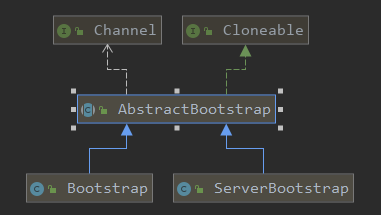
1、Bootstrap类是客户端程序的启动引导类
Bootstrap ⽤于启动⼀个 Netty TCP 客户端,或者 UDP 的⼀端。通常使⽤ #connet(...) ⽅法连接到远程的主机和端⼝,作为⼀个 Netty TCP 客户端。也可以通过 #bind(...) ⽅法绑定本地的⼀个端⼝,作为 UDP 的⼀端。仅仅需要使⽤⼀个 EventLoopGroup,也就是workerGroup。
代码样例:
Bootstrap bootstrap = new Bootstrap(); //设置相关参数 bootstrap.group(group) //设置线程组,只需要一个group .channel(NioSocketChannel.class) // 设置客户端通道的实现类(反射) .handler(new ChannelInitializer<SocketChannel>() { @Override protected void initChannel(SocketChannel ch) throws Exception { ch.pipeline().addLast(new NettyClientHandler()); //加入自己的处理器 } });//启动客户端去连接服务器端 ChannelFuture channelFuture = null; try { channelFuture = bootstrap.connect("127.0.0.1", 6668).sync(); } catch (InterruptedException e) { e.printStackTrace(); }
2、ServerBootstrap是服务端启动引导类
ServerBootstrap 往往是⽤于启动⼀个 Netty 服务端。通常使⽤ #bind(...) ⽅法绑定本地的端⼝上,然后等待客户端的连接。使⽤两个 EventLoopGroup 对象( 当然这个对象可以引⽤同⼀个对象 ):bossGroup 只是处理连接请求 , 真正的和客户端业务处理,会交给 workerGroup完成。
代码样例:
EventLoopGroup bossGroup = new NioEventLoopGroup(1); EventLoopGroup workerGroup = new NioEventLoopGroup(); try { //创建服务器端的启动对象,配置参数 ServerBootstrap bootstrap = new ServerBootstrap(); //使用链式编程来进行设置 bootstrap.group(bossGroup, workerGroup) //设置两个线程组 .channel(NioServerSocketChannel.class) //使用NioSocketChannel 作为服务器的通道实现 .option(ChannelOption.SO_BACKLOG, 128) // 设置线程队列得到连接个数 .childOption(ChannelOption.SO_KEEPALIVE, true) //设置保持活动连接状态 // .handler(null) // 该 handler对应 bossGroup , childHandler 对应 workerGroup .childHandler(new ChannelInitializer<SocketChannel>() {//创建一个通道初始化对象(匿名对象) //给pipeline 设置处理器 @Override protected void initChannel(SocketChannel ch) throws Exception { System.out.println("客户socketchannel hashcode=" + ch.hashCode()); //可以使用一个集合管理 SocketChannel, 再推送消息时,可以将业务加入到各个channel 对应的 NIOEventLoop 的 taskQueue 或者 scheduleTaskQueue ch.pipeline().addLast(new NettyServerHandler()); } }); // 给我们的workerGroup 的 EventLoop 对应的管道设置处理器 System.out.println(".....服务器 is ready..."); //绑定一个端口并且同步, 生成了一个 ChannelFuture 对象 //启动服务器(并绑定端口) ChannelFuture cf = bootstrap.bind(6668).sync();
3、常用方法
这两个类都继承了AbstractBootstrap,因此它们有很多相同的⽅法和职责。它们都是启动器,能够帮助 Netty 使⽤者更加⽅便地组装和配置 Netty ,也可以更⽅便地启动 Netty 应⽤程序。相⽐使⽤者⾃⼰从头去将 Netty 的各部分组装起来要⽅便得多,降低了使⽤者的学习和使⽤成本。它们是我们使⽤ Netty 的⼊⼝和最重要的 API ,可以通过它来连接到⼀个主机和端⼝上,也可以通过它来绑定到⼀个本地的端⼝上。总的来说,它们两者之间相同之处要⼤于不同。
Bootstrap & ServerBootstrap 对于 Netty ,就相当于 Spring Boot 是 Spring 的启动器。它们和其它组件之间的关系是它们将 Netty 的其它组件进⾏组装和配置,所以它们会组合和直接或间接依赖其它的类。
常见方法(这些方法在示例代码中都可以找到):
public ServerBootstrap group(EventLoopGroup parentGroup, EventLoopGroup childGroup) //该⽅法⽤于服务器端,⽤来设置两个 EventLoop public B group(EventLoopGroup group) //该⽅法⽤于客户端,⽤来设置⼀个 EventLoop public B channel(Class<? extends C> channelClass) //该⽅法⽤来设置⼀个服务器端的通道实现 public <T> B option(ChannelOption<T> option, T value) //⽤来给 ServerChannel 添加配置 public <T> ServerBootstrap childOption(ChannelOption<T> childOption, T value) //⽤来给接收到的通道添加配置 xxx.handler(null) // 该 handler对应 bossGroup , childHandler 对应 workerGroup public ServerBootstrap childHandler(ChannelHandler childHandler) //childHandler 对应 workerGroup,该⽅法⽤来设置业务处理类(⾃定义的 handler) public ChannelFuture bind(int inetPort) //该⽅法⽤于服务器端,⽤来设置占⽤的端⼝号 public ChannelFuture connect(String inetHost, int inetPort) //该⽅法⽤于客户端,⽤来连接服务器端
三、ChannelFuture
//b为ServerBootstrap实例 ChannelFuture f = b.bind().sync();
Channel channel() //返回当前正在进⾏ IO 操作的通道 ChannelFuture sync() //等待异步操作执⾏完毕
这也是Netty异步模型的具体体现。
代码示例:
//绑定一个端口并且同步, 生成了一个 ChannelFuture 对象 //启动服务器(并绑定端口) ChannelFuture cf = bootstrap.bind(6668).sync(); //给cf 注册监听器,监控我们关心的事件 cf.addListener(new ChannelFutureListener() { @Override public void operationComplete(ChannelFuture future) throws Exception { if (cf.isSuccess()) { System.out.println("监听端口 6668 成功"); } else { System.out.println("监听端口 6668 失败"); } } }); //对关闭通道进行监听 cf.channel().closeFuture().sync();
四、Selector
Netty基于java.nio.channels.Selector对象实现IO多路复⽤,通过Selector⼀个线程可以监听多个连接的Channel事件。当向⼀个Selector中注册Channel后,Selector内部的机制就可以⾃动不断的Select这些注册的Channel是否有就绪的IO事件(可读、可写、⽹络连接完成等)。
⼀个NioEventLoop中会有⼀个线程以及⼀个Selector, 这个线程就是我们所说的I/O线程。
五、Channel家族
Netty跟Channel相关的组件有Channel、ChannelHandler、ChannelContext、ChannelPipeline、ChannelOption,其中:
Channel是网络操作的抽象类,使用外观模式对外统一提供一组操作
ChannelHandler是实际的操作处理类
ChannelHandlerContext是保存ChannelHandler上下文信息的
ChannelPipeline是一组ChannelHandler的集合,用于拦截出入站的操作,使用责任链模式交给各个Handler处理。
ChannelOption是Channel的配置类。
(一)Channel
Channel 是 Netty ⽹络操作抽象类,使⽤了Facade 模式(外观模式)聚合了⼀组功能,除了包括基本的 I/O 操作,如 bind、connect、read、write 之外,还包括了 Netty 框架相关的⼀些功能,如获取该 Channel的 EventLoop 。
1、Channel主要功能:
⽹络的读写
客户端发起连接、主动关闭连接
链路关闭
获取通信双⽅的⽹络地址
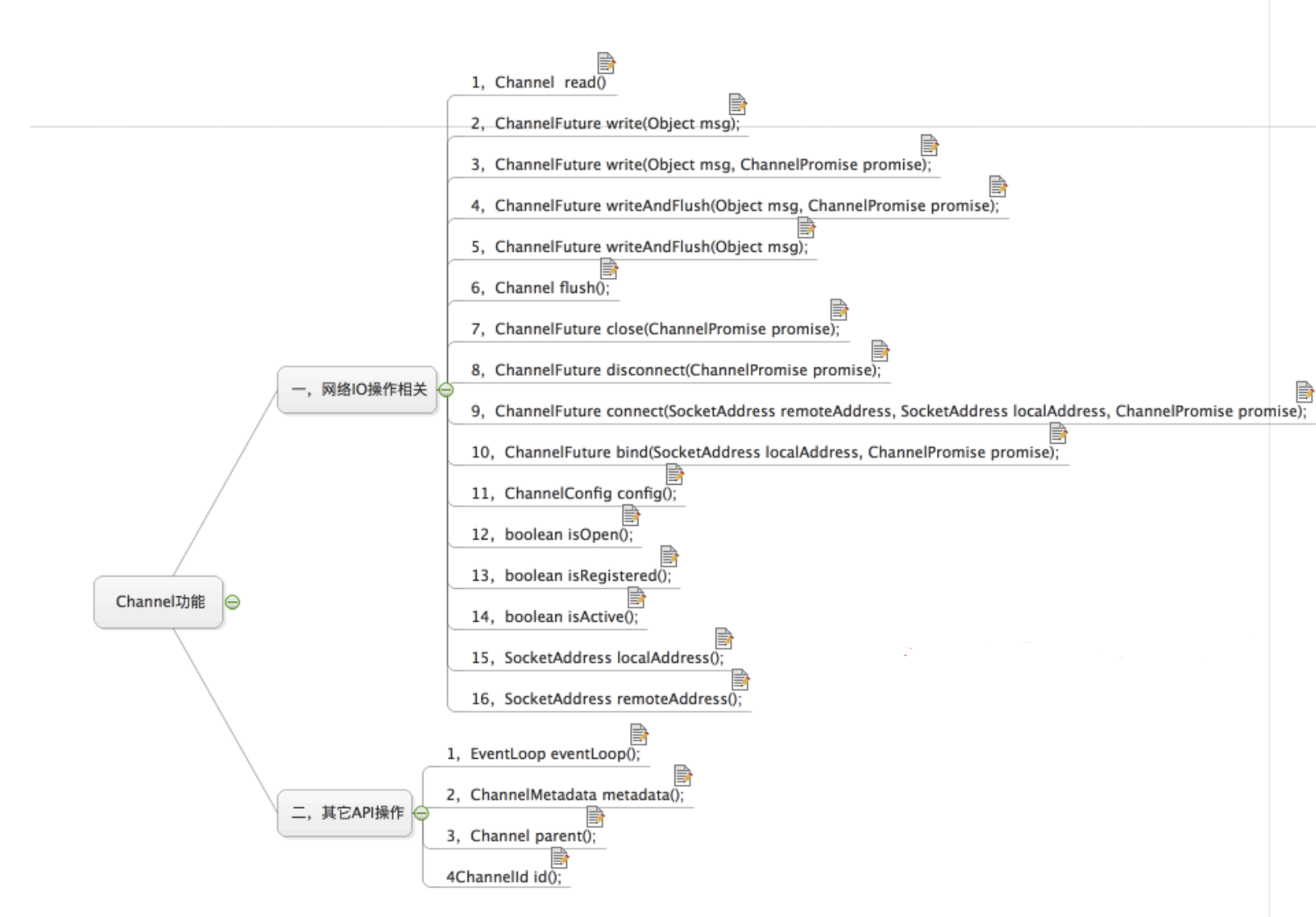
2、Channel设计理念:
在Channel 接⼝层,采⽤ Facade 模式进⾏统⼀封装,将⽹络I/O 操作、⽹络I/O 相关联的其他操作封装起来,统⼀对外提供。
Channel 接⼝的定义:⼤⽽全,为SocketChannel 和ServerSocketChannel 提供统⼀试图,由不同⼦类现实不同的功能,公共功能在抽象⽗类中实现,最⼤程度地实现功能和接⼝的重⽤。
具体实现采⽤聚合模式⽽⾮组合模式,将相关的功能类聚合在Channel中,由Channel 统⼀负责分配和调度,功能实现更加灵活。
3、不同协议、不同的阻塞类型的连接都有不同的 Channel 类型与之对应,常⽤的 Channel 类型:

NioSocketChannel:异步的客户端 TCP Socket 连接。NioServerSocketChannel是异步的服务器端 TCP Socket 连接。NioDatagramChannel是异步的 UDP 连接。NioSctpChannel是异步的客户端 Sctp 连接。NioSctpServerChannel是异步的 Sctp 服务器端连接,这些通道涵盖了UDP 和 TCP ⽹络 IO 以及⽂件 IO。
4、Channel继承关系
server端 & 客户端
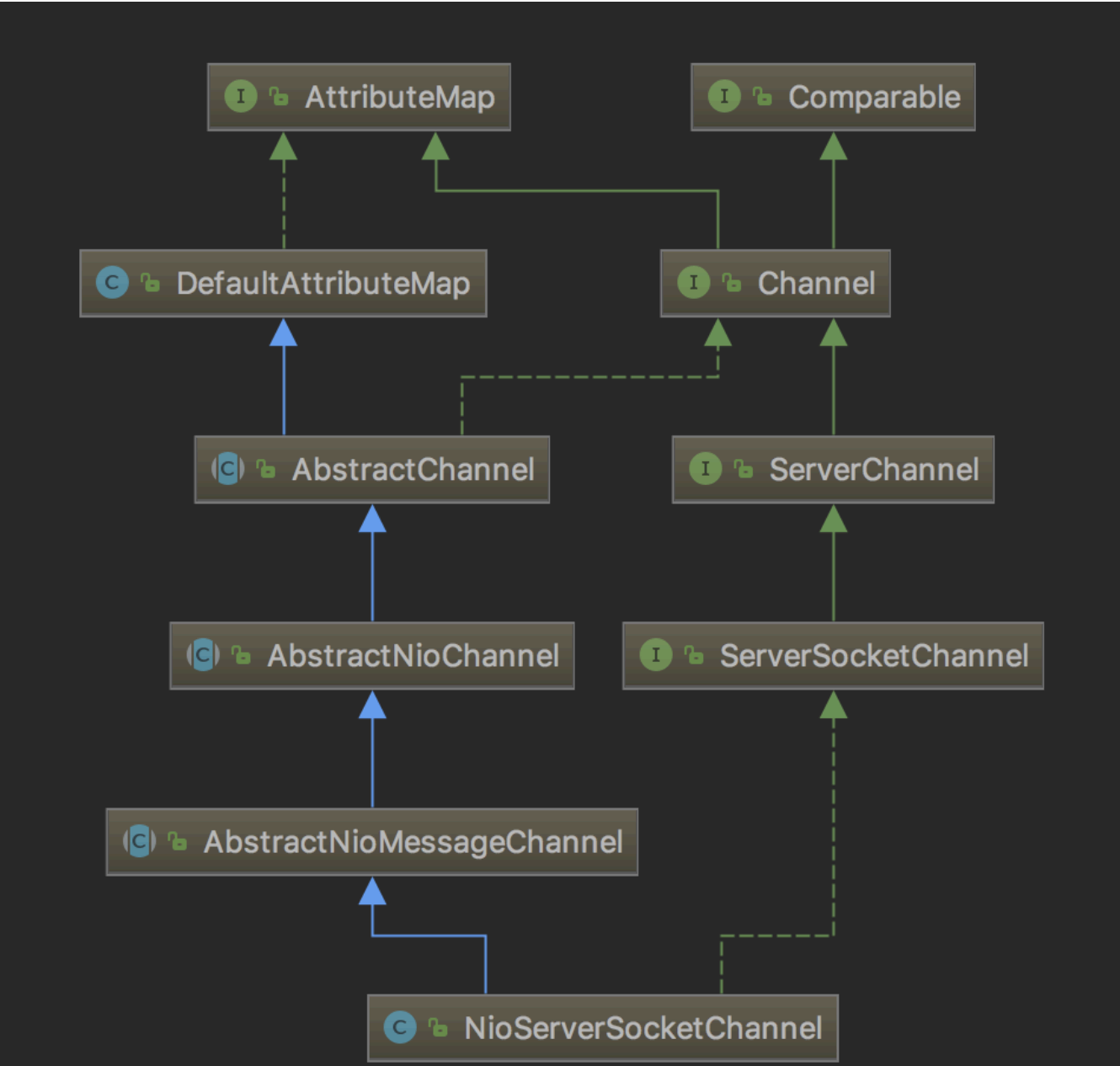

5、外观模式
这里提一下外观模式,外观模式,⼜叫⻔⾯模式,是⼀种通过为多个复杂的⼦系统提供⼀个⼀致的接⼝,⽽使这些⼦系统更加容易被访问的模式。该模式对外有⼀个统⼀接⼝,外部应⽤程序不⽤关⼼内部⼦系统的具体的细节,这样会⼤⼤降低应⽤程序的复杂度,提⾼了程序的可维护性。
外观(Facade)模式的结构⽐较简单,主要是定义了⼀个⾼层接⼝。它包含了对各个⼦系统的引⽤,客户端可以通过它访问各个⼦系统的功能。现在来分析其基本结构和实现⽅法。
外观(Facade)模式包含以下主要⻆⾊。
外观(Facade)⻆⾊:为多个⼦系统对外提供⼀个共同的接⼝。
⼦系统(Sub System)⻆⾊:实现系统的部分功能,客户可以通过外观⻆⾊访问它。
客户(Client)⻆⾊:通过外观⻆⾊访问各个⼦系统的功能。
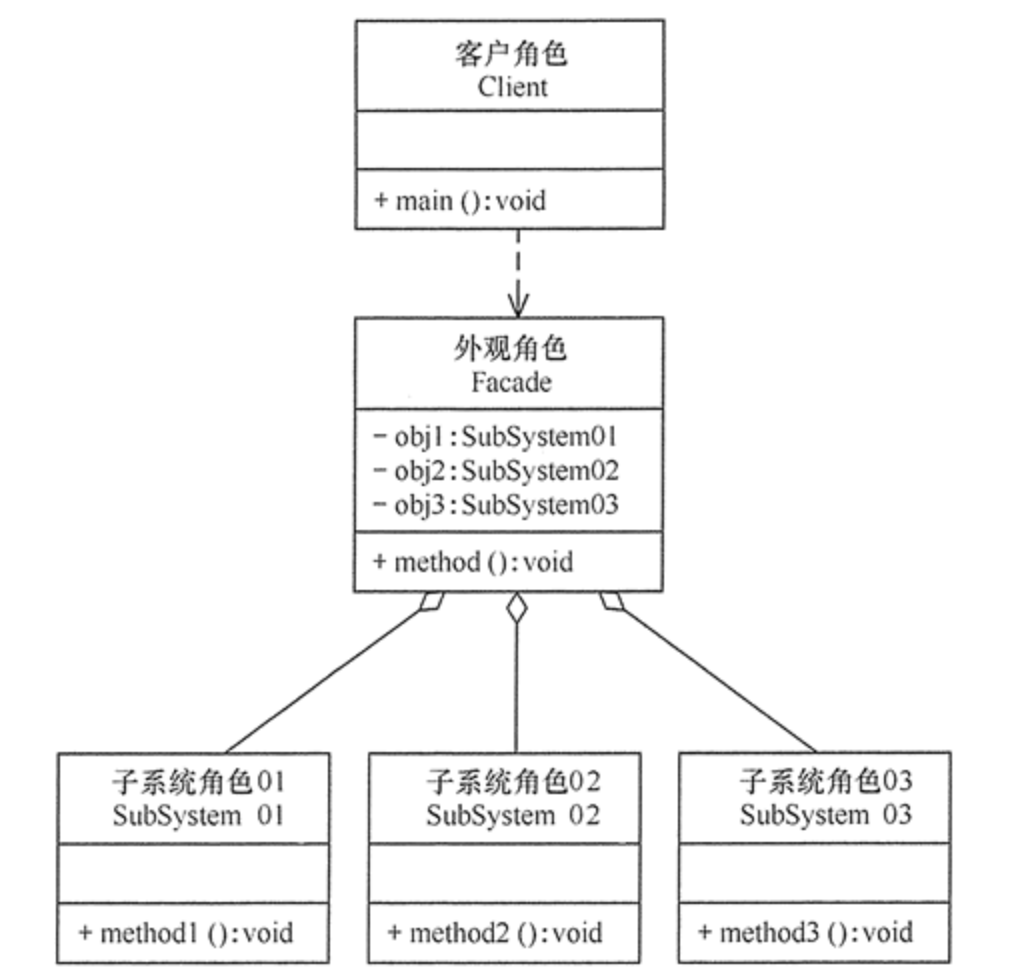
(二)ChannelHandler
ChannelHandler属于业务的核⼼接⼝,处理 I/O 事件或拦截 I/O 操作,并将其转发到其hannelPipeline(业务处理链)。ChannelHandler 本身并没有提供很多⽅法,因为这个接⼝有许多的⽅法需要实现,⽅便使⽤期间,可以继承它的⼦类。
ChannelHandler 及其实现类⼀览图
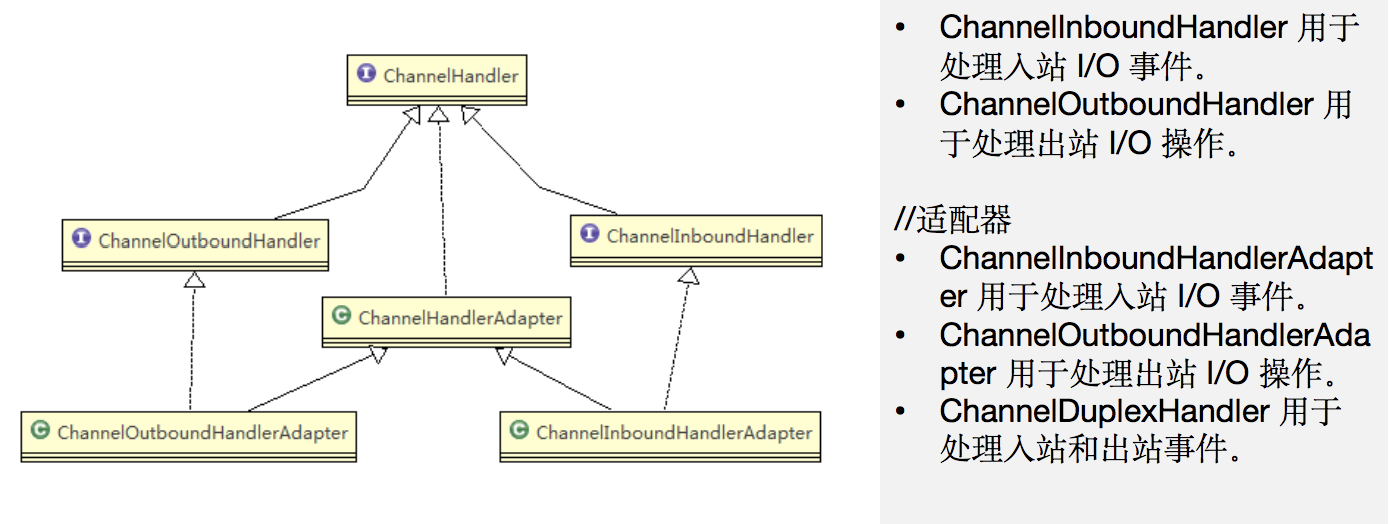
ChannelHandler⾥⾯定义三个⽣命周期⽅法,分别会在当前ChannelHander加⼊ChannelHandlerContext、从ChannelHandlerContext中移除、以及ChannelHandler回调⽅法出现异常时被回调。

主要实现它的⼦接⼝有两个ChannelInboundHandler和ChannelOutboundHandler。为了便利,框架提供了ChannelInboundHandlerAdapter,ChannelOutboundHandlerAdapter和ChannelDuplexHandler这三个适配类提供⼀些默认实现,在使⽤的时候只需要实现关注的⽅法即可。
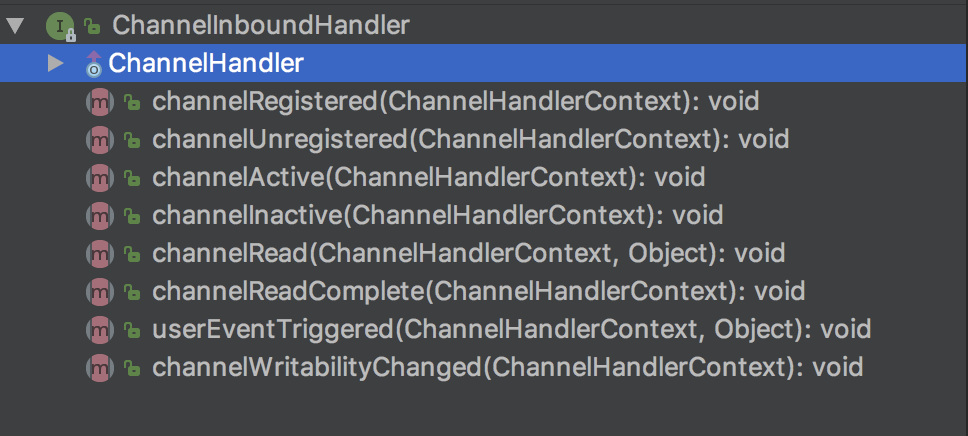
介绍⼀下这些回调⽅法被触发的时机:
channelRegistered:当前channel注册到EventLoop
channelUnregistered:当前channel从EventLoop取消注册
channelActive:当前channel活跃的时候
channelInactive:当前channel不活跃的时候,也就是当前channel到了它⽣命周期末
channelRead:当前channel从远端读取到数据
channelReadComplete:channel read消费完读取的数据的时候被触发
userEventTriggered:⽤户事件触发的时候
channelWritabilityChanged:channel的写状态变化的时候触发
可以注意到每个⽅法都带了ChannelHandlerContext作为参数,具体作⽤是,在每个回调事件⾥⾯,处理完成之后,使⽤ChannelHandlerContext的fireChannelXXX⽅法来传递给下个ChannelHandler,netty的codec模块和业务处理代码分离就⽤到了这个链路处理
2、ChannelOutboundHandler

被触发的时机:
bind:bind操作执⾏前触发
connect:connect 操作执⾏前触发
disconnect:disconnect 操作执⾏前触发
close:close操作执⾏前触发
deregister:deregister操作执⾏前触发
read: read操作执⾏前触发
write: write操作执⾏前触发
flush: flush操作执⾏前触发
注意到⼀些回调⽅法有ChannelPromise这个参数,我们可以调⽤它的addListener注册监听,当回调⽅法所对应的操作完成后,会触发这个监听 下⾯这个代码,会在写操作完成后触发,完成操作包括成功和失败
public void write(ChannelHandlerContext ctx, Object msg, ChannelPromise promise) throws Exception { ctx.write(msg,promise); System.out.println("out write"); promise.addListener(new GenericFutureListener<Future<? super Void>>() { @Override public void operationComplete(Future<? super Void> future) throws Exception { if(future.isSuccess()){ System.out.println("OK"); } } }); }
3、ChannelInboundHandler和ChannelOutboundHandler的区别
ChannelInboundHandler的channelRead回调负责执⾏⼊栈数据的decode逻辑(解码),而ChannelOutboundHandler的write负责执⾏出站数据的encode⼯作(编码),其他回调⽅法和具体触发逻辑有关,和in与out⽆关。
4、代码示例
经常需要⾃定义⼀个 Handler 类去继承 ChannelInboundHandlerAdapter,然后通过重写相应⽅法实现业务逻辑。前面的代码示例中自定义的handler就继承了ChannelInboundHandlerAdapter,就用到了channelRead、channelReadComplete、execeptionCaught、channelActive这些方法。
(三) ChannelHandlerContext
保存 Channel 相关的所有上下⽂信息,同时关联⼀个 ChannelHandler 对象。即 ChannelHandlerContext 中包含⼀个具体的事件处理器 ChannelHandler,同时ChannelHandlerContext 中也绑定了对应的 pipeline 和 Channel 的信息,⽅便对 ChannelHandler 进⾏调⽤。
每个ChannelHandler通过add⽅法加⼊到ChannelPipeline中去的时候,会创建⼀个对应的ChannelHandlerContext,并且绑定,ChannelPipeline实际维护的是ChannelHandlerContext 的关系。每个ChannelHandlerContext之间形成双向链表。
在DefaultChannelPipeline源码中可以看到会保存第⼀个ChannelHandlerContext以及最后⼀个ChannelHandlerContext的引⽤
public class DefaultChannelPipeline implements ChannelPipeline { ..... final AbstractChannelHandlerContext head; final AbstractChannelHandlerContext tail; .... }
⽽在AbstractChannelHandlerContext源码中可以看到
abstract class AbstractChannelHandlerContext implements ChannelHandlerContext, ResourceLeakHint { ........... volatile AbstractChannelHandlerContext next; volatile AbstractChannelHandlerContext prev; .... }
也就是说,ChannelHandlerContext和ChannelPipeline是相互关联的,并且在自己中存储了对方的上一个节点和下一个节点。
ChannelHandlerContext中常⽤⽅法:

(四)ChannelPipeline
1、ChannelPipeline介绍
ChannelPipeline 是⼀个 Handler 的集合,它负责处理和拦截 inbound 或者 outbound 的事件和操作,相当于⼀个贯穿 Netty 的链。(也可以这样理解:ChannelPipeline 是保存ChannelHandler 的 List,⽤于处理或拦截 Channel 的⼊站事件和出站操作);ChannelPipeline 实现了⼀种⾼级形式的拦截过滤器模式,使⽤户可以完全控制事件的处理⽅式,以及 Channel 中各个的 ChannelHandler 如何相互交互;每个 Channel 都有且仅有⼀个 ChannelPipeline 与之对应, ⼀个 Channel 包含了⼀个ChannelPipeline,⽽ ChannelPipeline 中⼜维护了⼀个由 ChannelHandlerContext 组成的双向链表,并且每个 ChannelHandlerContext 中⼜关联着⼀个 ChannelHandler。
它们的组成关系如下:

⼊站事件和出站事件在⼀个双向链表中,⼊站事件会从链表head往后传递到最后⼀个⼊站的handler,出站事件会从链表tail往前传递到最前⼀个出站的handler,两种类型的handler互不⼲扰。
2、ChannelPipeline初始化

在Channel创建的时候,会同时创建ChannelPipeline
public abstract class AbstractChannel extends DefaultAttributeMap implements Channel { ..... private final DefaultChannelPipeline pipeline; ..... protected AbstractChannel(Channel parent) { this.parent = parent; id = newId(); unsafe = newUnsafe(); pipeline = newChannelPipeline(); } .... }
在ChannelPipeline中也会持有Channel的引⽤
public class DefaultChannelPipeline implements ChannelPipeline { .... private final Channel channel; .... protected DefaultChannelPipeline(Channel channel) { this.channel = ObjectUtil.checkNotNull(channel, "channel"); succeededFuture = new SucceededChannelFuture(channel, null); voidPromise = new VoidChannelPromise(channel, true); tail = new TailContext(this); head = new HeadContext(this); head.next = tail; tail.prev = head; } .... }
ChannelPipeline会维护⼀个ChannelHandlerContext的双向链表
public class DefaultChannelPipeline implements ChannelPipeline { ..... final AbstractChannelHandlerContext head; final AbstractChannelHandlerContext tail; ... }
链表的头尾有默认实现
protected DefaultChannelPipeline(Channel channel) { this.channel = ObjectUtil.checkNotNull(channel, "channel"); succeededFuture = new SucceededChannelFuture(channel, null); voidPromise = new VoidChannelPromise(channel, true); tail = new TailContext(this); head = new HeadContext(this); head.next = tail; tail.prev = head; }
3、⼊站事件和出站事件
pipeline保存了通道所有的处理器信息,在创建⼀个channel的时候,会创建⼀个这个channel专有的pipeline,⼊站事件和出站事件都会调⽤这个pipeline上⾯的处理器。
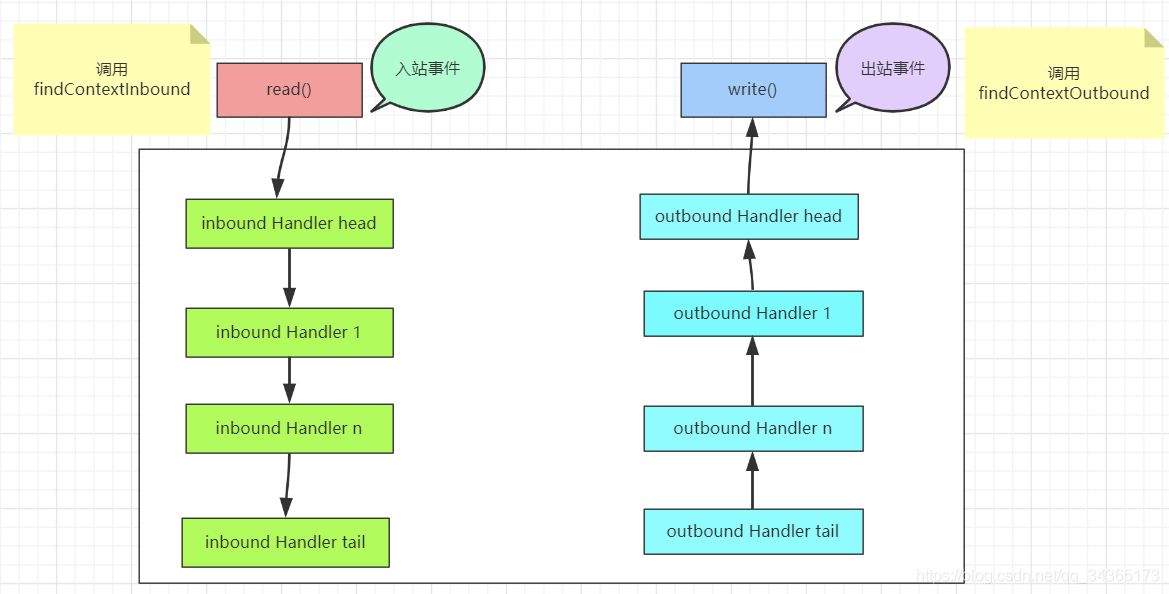
abstract class AbstractChannelHandlerContext implements ChannelHandlerContext, ResourceLeakHint { .......... private AbstractChannelHandlerContext findContextInbound(int mask) { AbstractChannelHandlerContext ctx = this; EventExecutor currentExecutor = executor(); do { ctx = ctx.next; } while (skipContext(ctx, currentExecutor, mask, MASK_ONLY_INBOUND)); return ctx; } private AbstractChannelHandlerContext findContextOutbound(int mask) { AbstractChannelHandlerContext ctx = this; EventExecutor currentExecutor = executor(); do { ctx = ctx.prev; } while (skipContext(ctx, currentExecutor, mask, MASK_ONLY_OUTBOUND)); return ctx; } ..........
上⾯两个⽅法的作⽤,是判断下⼀个context是不是⼊站或者出站事件,是的话才往下传递数据。
4、HeadContext
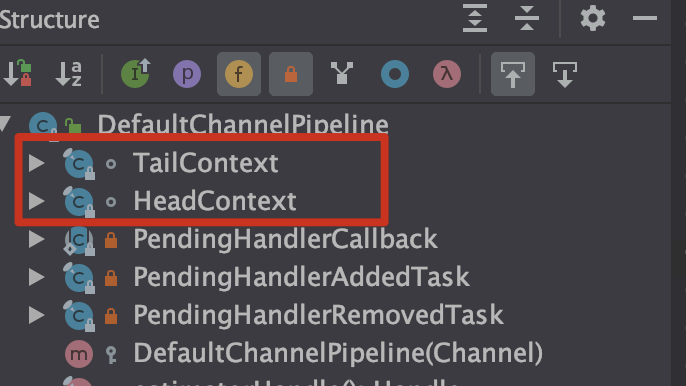
HeadContext实现了ChannelOutboundHandler,ChannelInboundHandler这两个接⼝:
final class HeadContext extends AbstractChannelHandlerContext implements ChannelOutboundHandler, ChannelInboundHandler {
因为在头部,所以说HeadContext中关于in和out的回调⽅法都会触发关于ChannelInboundHandler,HeadContext的作⽤是进⾏⼀些前置操作,以及把事件传递到下⼀个ChannelHandlerContext的ChannelInboundHandler中去。看下其中channelRegistered的实现
@Override public void channelRegistered(ChannelHandlerContext ctx) { invokeHandlerAddedIfNeeded(); ctx.fireChannelRegistered(); }
从语义上可以看出来在把这个事件传递给下⼀个ChannelHandler之前会回调ChannelHandler的handlerAdded⽅法。
⽽有关ChannelOutboundHandler接⼝的实现,会在链路的最后执⾏,看下write⽅法的实现
public void write(ChannelHandlerContext ctx, Object msg, ChannelPromise promise) throws Exception { unsafe.write(msg, promise); }
这边的unsafe接⼝封装了底层Channel的调⽤,之所以取名为unsafe,是不需要⽤户⼿动去调⽤这些⽅法。(这个和阻塞原语的unsafe不是同⼀个)
5、TailContext
TailContext实现了ChannelInboundHandler接⼝,会在ChannelInboundHandler调⽤链最后执⾏,只要是对调⽤链完成处理的情况进⾏处理,看下channelRead实现
final class TailContext extends AbstractChannelHandlerContext implements ChannelInboundHandler { public void channelRead(ChannelHandlerContext ctx, Object msg) throwsException { onUnhandledInboundMessage(msg); } }
channelRead中的onUnhandledInboundMessage⽅法,会把msg资源回收,防⽌内存泄露
protected void onUnhandledInboundMessage(ChannelHandlerContext ctx, Object msg) { onUnhandledInboundMessage(msg); if (logger.isDebugEnabled()) { logger.debug("Discarded message pipeline : {}. Channel : {}.", ctx.pipeline().names(), ctx.channel()); } }
protected void onUnhandledInboundMessage(Object msg) { try { logger.debug( "Discarded inbound message {} that reached at the tail of the pipeline. " + "Please check your pipeline configuration.", msg); } finally { ReferenceCountUtil.release(msg); } }
6、组件之间的关系

(1)每个Channel会绑定⼀个ChannelPipeline,每个ChannelPipeline会持有⼀个Channel,两者相互引用
(2)每个ChannelHandler对应⼀个ChannelHandlerContext,ChannelPipeline持有ChannelHandlerContext链表,也就相当于持有ChannelHandler链表
(3)ChannelHandlerContext作为上下⽂,持有ChannelPipeline和它对应ChannelHandler的引⽤,持有ChannelPipeline相当于间接持有Channel,同时持有它上/下⼀个ChannelHandlerContext的引⽤
7、责任链模式
ChannelPipeline使用的是责任链模式,顺序的执行链条上的每一个handler。
责任链模式为请求创建⼀个处理数据的链。 客户端发起的请求和具体处理请求的过程进⾏了解耦,责任链上的处理者负责处理请求,客户端只需要把请求发送到责任链就⾏了,不需要去关⼼具体的处理逻辑和处理请求在责任链中是怎样传递的。
1、处理器抽象类
2、处理器抽象类的具体实现类
3、保存和维护处理器信息的类
4、处理器执⾏的类
下⾯看⼀个简单的demo,基于责任链模式的思想:
public class PipelineDemo { //初始化链的头部 public HandlerContext head = new HandlerContext(new AbstractHandler() { @Override void doHandler(HandlerContext context, Object arg) { context.runNext(arg); } }); //开始执⾏ public void request(Object arg) { this.head.handler(arg); } //添加节点到尾部 public void addLast(AbstractHandler handler) { HandlerContext context = head; while (context.next != null) { context = context.next; } context.next = new HandlerContext(handler); } public static void main(String[] args) { PipelineDemo pipelineChainDemo = new PipelineDemo(); pipelineChainDemo.addLast(new Handler2()); pipelineChainDemo.addLast(new Handler1()); pipelineChainDemo.addLast(new Handler1()); pipelineChainDemo.addLast(new Handler2()); // 发起请求 pipelineChainDemo.request("⽕⻋呜呜呜~~"); } } //处理器的信息,维护处理器 class HandlerContext { //下⼀个节点 HandlerContext next; AbstractHandler handler; public HandlerContext(AbstractHandler handler) { this.handler = handler; } void handler(Object arg) { this.handler.doHandler(this, arg); } //执⾏下⼀个 void runNext(Object arg) { if (this.next != null) { this.next.handler(arg); } } //处理器抽象类 abstract class AbstractHandler { abstract void doHandler(HandlerContext context, Object arg); } //处理器的具体实现类 class Handler1 extends AbstractHandler { @Override void doHandler(HandlerContext context, Object arg) { arg = arg.toString() + "Handler1的⼩尾巴~~"; System.out.println("Handler1的实例正在处理:" + arg); //执⾏下⼀个 context.runNext(arg); } } //处理器的具体实现类 class Handler2 extends AbstractHandler { @Override void doHandler(HandlerContext context, Object arg) { arg = arg.toString() + "Handler2的⼩尾巴~~"; System.out.println("Handler2的实例正在处理:" + arg); //执⾏下⼀个 context.runNext(arg); } }
(五)ChannelOption
ChannelConfig是Channel的配置类, ⽽ChannelConfig内部各种配置选项依赖于ChannelOption类的实现,可以认为ChannelConfig中⽤了⼀个Map来保存参数,Map的key是ChannelOption,ChannelConfig 定义了相关⽅法来获取和修改Map中的值。
public interface ChannelConfig { ... Map<ChannelOption<?>, Object> getOptions();//获取所有参数 boolean setOptions(Map<ChannelOption<?>, ?> options);//替换所有参数 <T> T getOption(ChannelOption<T> option);//获取以某个ChannelOption为key的参数值 <T> boolean setOption(ChannelOption<T> option, T value);//替换某个ChannelOption为key的参数值 .... }
ChannelOption定义了对⼀个Channel的各种属性配置选项,包括了各种底层连接的详细信息,如keep-alive或者超时属性以及缓冲区的设置等。

六、EventLoopGroup 和 NioEventLoopGroup
1、ServerSocketChannel 与 SocketChannel
EventLoopGroup 是⼀组 EventLoop 的抽象,Netty 为了更好的利⽤多核 CPU 资源,⼀般会有多个 EventLoop 同时⼯作,每个 EventLoop 维护着⼀个 Selector 实例。EventLoopGroup 提供 next 接⼝,可以从组⾥⾯按照⼀定规则获取其中⼀个 EventLoop 来处理任务。在 Netty 服务器端编程中,我们⼀般都需要提供两个 EventLoopGroup,例如:BossEventLoopGroup 和 WorkerEventLoopGroup。
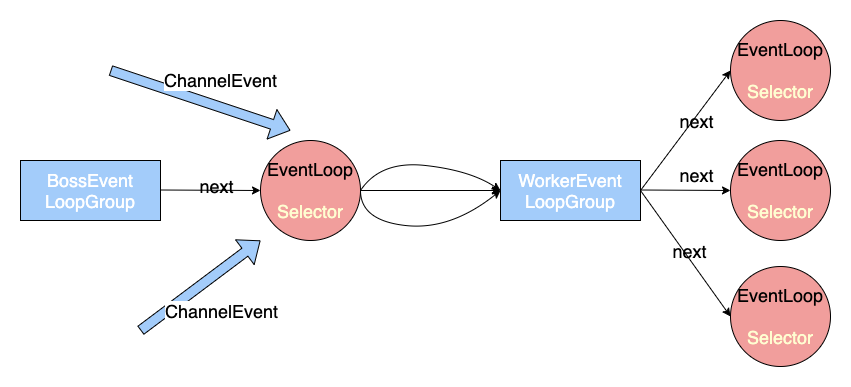
BossEventLoopGroup通常是⼀个单线程的EventLoop,EventLoop维护着⼀个注册了ServerSocketChannel的Selector实例。BossEventLoop不断轮询Selector将连接事件分离出来。通常是OP_ACCEPT事件,然后将受到SocketChannel交给WokerEventLoopGroup。WokerEventLoopGroup会有next选择其中⼀个EventLoop来将这个SocketChannel注册到其维护的Selector并对其后续的IO事件进⾏处理。
2、EventLoop与Channel
EventLoop进⾏的是Selector的维护。EventLoopGroup⽤于线程组维护,并发控制,任务处理。
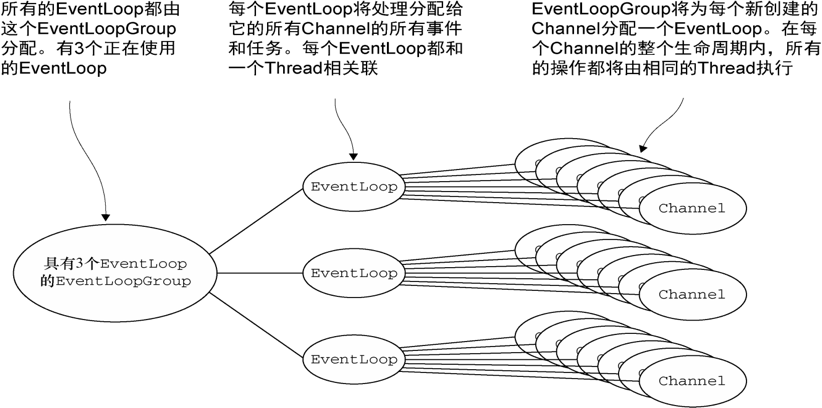
3、任务执⾏
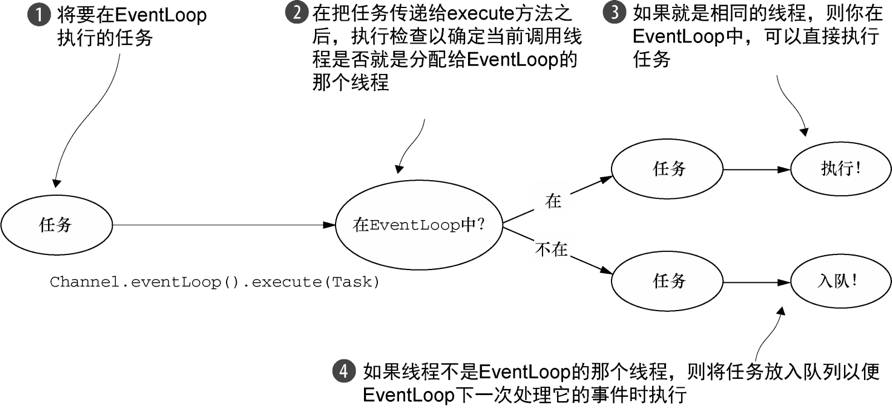
关于EventLoop以及EventLoopGroup的映射关系为:
⼀个EventLoopGroup 包含⼀个或者多个EventLoop;
⼀个EventLoop 在它的⽣命周期内只和⼀个Thread 绑定;
所有由EventLoop 处理的I/O 事件都将在它专有的Thread 上被处理;
⼀个Channel 在它的⽣命周期内只注册于⼀个EventLoop;
⼀个EventLoop 可能会被分配给⼀个或多个Channel。
Channel 为Netty ⽹络操作抽象类,EventLoop 主要是为Channel 处理 I/O 操作,两者配合参与I/O 操作。当⼀个连接到达时,Netty 就会注册⼀个 Channel,然后从 EventLoopGroup 中分配⼀个EventLoop 绑定到这个Channel上,在该Channel的整个⽣命周期中都是有这个绑定的 EventLoop 来服务的。
4、常⽤⽅法
public NioEventLoopGroup(),构造⽅法 public Future<?> shutdownGracefully(),断开连接,关闭线程
七、ByteBuf
1、Unpooled
Netty 提供⼀个专⻔⽤来操作缓冲区(即 Netty 的数据容器)的⼯具类Unpooled,常⽤⽅法
/** 通过给定的数据和字符编码返回⼀个ByteBuf 对象(类似NIO中的ByteBuffer,但是有区别) **/ public static ByteBuf copiedBuffer(CharSequence string, Charset charset) { ObjectUtil.checkNotNull(string, "string"); if (CharsetUtil.UTF_8.equals(charset)) { return copiedBufferUtf8(string); } if (CharsetUtil.US_ASCII.equals(charset)) { return copiedBufferAscii(string); } if (string instanceof CharBuffer) { return copiedBuffer((CharBuffer) string, charset); } return copiedBuffer(CharBuffer.wrap(string), charset); }
2、ByteBuf的三个指针分别是:readerIndex(读指针)、writerIndex(写指针)、maxCapacity(最⼤容量)
ByteBuf与NIO中原生的ByteBuffer的区别就是ByteBuf提供了读指针、写指针、最大容量三个指针,分别用来指定读的位置、写的位置、以及最大容量,这样在进行读写切换时就不需要类似NIO使用flip从写模式转换为读模式,position 被重新设置为 0了,而是可以直接使用相应的指针就可以了。
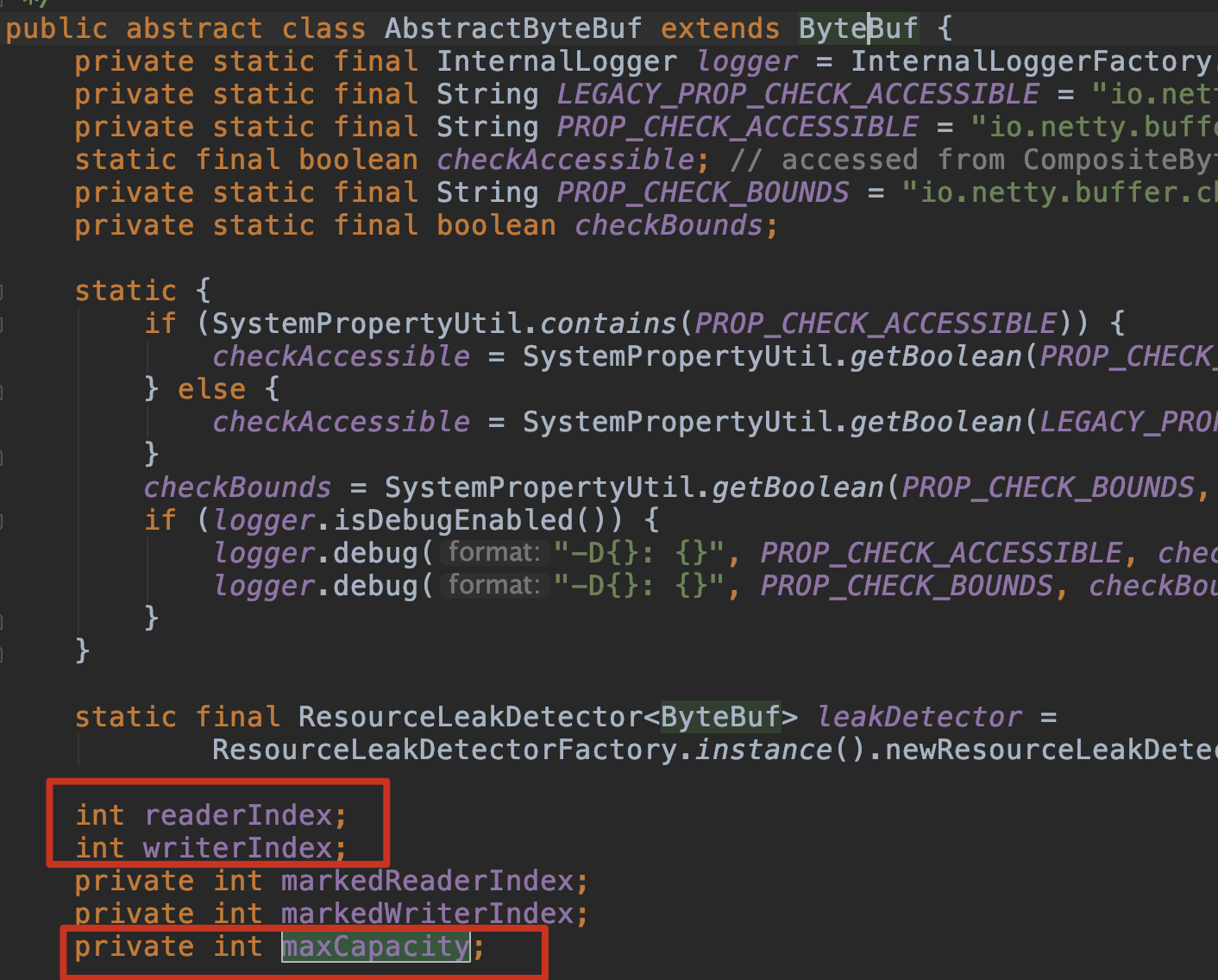
3、示例
示例一:
public class NettyByteBuf01 { public static void main(String[] args) { //创建一个ByteBuf //说明 //1. 创建 对象,该对象包含一个数组arr , 是一个byte[10] //2. 在netty 的buffer中,不需要使用flip 进行反转 // 底层维护了 readerindex 和 writerIndex //3. 通过 readerindex 和 writerIndex 和 capacity, 将buffer分成三个区域 // 0---readerindex 已经读取的区域 // readerindex---writerIndex , 可读的区域 // writerIndex -- capacity, 可写的区域 ByteBuf buffer = Unpooled.buffer(10); for (int i = 0; i < 10; i++) { buffer.writeByte(i); } System.out.println("capacity=" + buffer.capacity());//10 //输出 // for(int i = 0; i<buffer.capacity(); i++) { // System.out.println(buffer.getByte(i)); // } for (int i = 0; i < buffer.capacity(); i++) { System.out.println(buffer.readByte()); } System.out.println("执行完毕"); } }
示例二:
public class NettyByteBuf02 { public static void main(String[] args) { //创建ByteBuf ByteBuf byteBuf = Unpooled.copiedBuffer("hello,world!", Charset.forName("utf-8")); //使用相关的方法 if (byteBuf.hasArray()) { // true byte[] content = byteBuf.array(); //将 content 转成字符串 System.out.println(new String(content, Charset.forName("utf-8"))); System.out.println("byteBuf=" + byteBuf); System.out.println(byteBuf.arrayOffset()); // 0 System.out.println(byteBuf.readerIndex()); // 0 System.out.println(byteBuf.writerIndex()); // 12 System.out.println(byteBuf.capacity()); // 64 //System.out.println(byteBuf.readByte()); // System.out.println(byteBuf.getByte(0)); // 104 int len = byteBuf.readableBytes(); //可读的字节数 12 System.out.println("len=" + len); //使用for取出各个字节 for (int i = 0; i < len; i++) { System.out.println((char) byteBuf.getByte(i)); } //按照某个范围读取 System.out.println(byteBuf.getCharSequence(0, 4, Charset.forName("utf-8"))); System.out.println(byteBuf.getCharSequence(4, 6, Charset.forName("utf-8"))); } } }
4、discardReadBytes
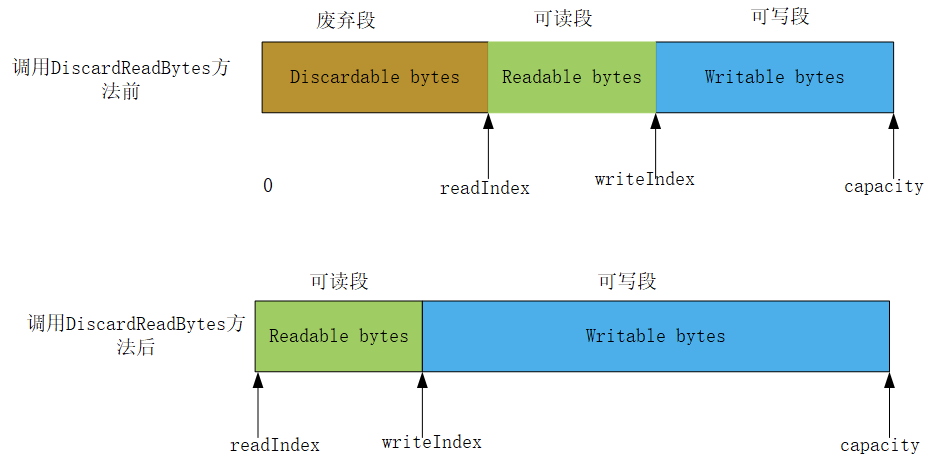
从上⾯的图中可以观察到,调⽤discardReadBytes⽅法后,readIndex置为0,writeIndex也往前移动了Discardable bytes⻓度的距离,扩⼤了可写区域。但是这种做法会严重影响效率,它进⾏了⼤量的拷⻉⼯作(将可读段往前复制、可写段往前复制)。
如果要进⾏数据的清除操作,建议使⽤clear⽅法。调⽤clear()⽅法将会将readIndex和writeIndex同时置为0,不会进⾏内存的拷⻉⼯作,同时要注意,clear⽅法不会清除内存中的内容,只是改变了索引位置⽽已。